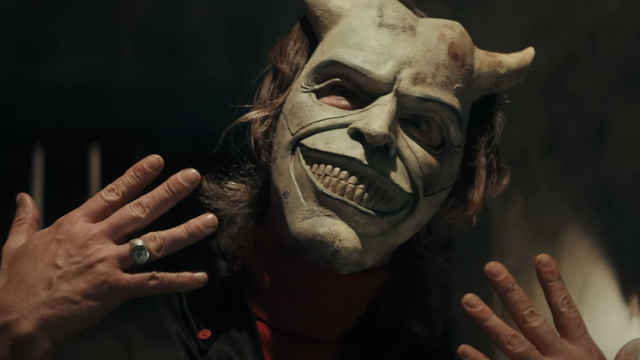As stated above, “The Black Phone” was one of several stories featured in Joe Hill’s collection of short stories.
However, while the film was praised for its faithfulness to the source material, as a far lengthier or at least more thorough adaptation of the source material, it explored the original tale in such depth that a sequel has been proposed, with Hill’s approval already granted.
The original short story from a book of horror stories with the same title as “The Black Phone” was published in 2005 as part of a more remarkable collection of Joe Hill’s short stories, and “The Black Phone” may be the most twisted of them all, as it may have opened the door for Universal to a new universe of films.
Synopsis of the Black Phone’s Story
In the event that you are ever confined in a basement and a black phone in the corner of the room begins to ring, we recommend answering it.
The caller on the phone could be your means of escape, especially if you are being held captive by a nasty serial murderer wearing a terrifying mask. Alternatively, it might be an incorrect number or a foreign contact center, but you should still answer the phone just in case!
Finney, the 13-year-old protagonist of Scott Derickson’s scary new horror film The Black Phone, decides to answer the phone. It is fortunate that he does so, as he receives advice from the past victims of the Grabber, the crazed psychopath who abducted this unfortunate young lad.

The Black Phone Ending Explained
After Finney is kidnapped by The Grabber, he is taken to his basement, which is nearly empty with the exception of an odd black phone on the wall that looks to be disconnected from its phone lines.
The Grabber asserts that he has heard the phone ring previously, albeit faintly, but as soon as Finney is left alone, he begins to hear it frequently. In addition, the persons on the other end of the line are all past Grabber captives who begin to offer him advice on how to escape his predicament.
Detectives investigating the case have begun questioning a guy named Max, who appears to be a conspiracy theorist and is conducting his own inquiry into the disappearance of the children. Max is quickly shown to be The Grabber’s brother, who is currently staying with him but is oblivious to his criminal activities.
Gwen, Finney’s sister, has been having nightmares that appear to reveal the location of the basement. When she finally deciphers the code, she runs to the police and tells them an address that she believes corresponds to The Grabber’s residence.
MUST READ:
- Barbarian Ending Explained: Who Was Carrying the Head at the End of Barbarians?
- The Big 4 Ending Explained: What Happened at the End of the Story?
Max has also deduced that the children had been in his brother’s residence; he visits the basement, where he is astonished to find Finney. Unfortunately, he doesn’t have much time to aid, as The Grabber quickly arrives on the scene and brutally executes his brother with an axe to the skull.
Finney is able to trip The Grabber and beat him with the phone, which then rings once more.
This time, all past victims are on the other end of the telephone, taunting their former captor until Finney kills him by snapping his neck.
The police and Gwen soon arrive on the scene, and Finney completes his escape, reuniting with his sister and his violent father, who apologizes for his actions.
The film concludes with Finney returning to school, where he is no longer targeted by the bullies who previously made his life miserable.
READ MORE:
- Rorschach Ending Explained: What Happened to Seetha and Anil?
- Pearl Ending Explained: Why Does Pearl Want to Leave the Farm?
In an exclusive interview with RadioTimes.com, Derrickson stated that audiences shouldn’t put too much thought into how the prior victims were able to reach Finney if they’re seeking an explanation for the supernatural elements of the plot.
“That is my general opinion on supernatural flicks,” he remarked. “It was similar to how I felt about Dr. Strange in many ways, you know, dealing with magic. I believe that once you cross the line from naturalism to the paranormal or supernatural, the audience will believe what you show them.
“The only rules I’m interested in explaining are those readers need to know to follow the story, but in my experience, people rarely ask for a lengthy explanation of how anything is possible or what the rules are until they’ll be lost without them.
“And I think part of the strength of paranormal storytelling and dealing with the mystical and the magical is allowing it to be enigmatic, letting it be something that feels perplexing even within the context of the story like there’s more to it than you can really grasp.
People Also Ask
Why Did the Thief Hear the Phone Ringing?
Finney hears the telephone ring and utilizes it as a means of coping with his overwhelming feelings of isolation and desperation. It is probable that, in order to make sense of his terrifying position and devise an efficient escape strategy, he imagines being directed by the souls of the killer’s deceased victims.
Who is the Black Phone’s Killer?
Albert Shaw, also known as The Grabber, is the main antagonist of the 2022 supernatural horror film The Black Phone, which is based on Joe Hill’s 2004 20th Century Ghosts collection short story of the same name. He is a serial kidnapper and murderer who targeted boys in a Denver suburb.
Why is the Thief Wearing a Mask?
The many Grabber mask modifications each symbolize characters in a show he is putting on for himself and his victims. Several sequences in The Black Phone imply a further reason for his mask: he hides from himself out of shame for his conduct.
